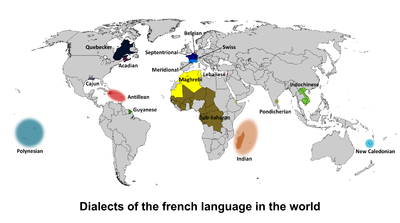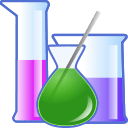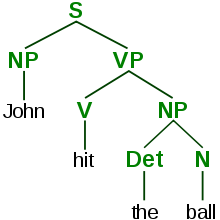
This world map shows the locations amongst the locals of the French language. Credit:
Jonatan argento.
There are "approximately 3,000–6,000 languages that are spoken by humans today".[1]
Linguistics
Theoretical languages
Def. "[a] form of communication using words either spoken or gestured with the hands and structured with grammar, often with a writing system"[2] is called a language.
"Language may refer either to the specifically human capacity for acquiring and using complex systems of communication, or to a specific instance of such a system of complex communication."[1]
If there is at least one human or hominin language, why are there more than one?
Dominant language

The Wikipedia dominant language by country is indicated by different colors. Credit:
Leonst & Sehrg.
Def. a "[l]anguage spoken by the dominant social group, or language that is seen as the main language of a country"[3] is called a dominant language.
Language families
Def. "[a] set of languages which have evolved from a common ancestor"[4] is called a language family.
Research
Hypothesis:
- Each of today's languages contains a synonym for dominant group.
Control groups

This is an image of a Lewis rat. Credit: Charles River Laboratories.
The findings demonstrate a statistically systematic change from the status quo or the control group.
“In the design of experiments, treatments [or special properties or characteristics] are applied to [or observed in] experimental units in the treatment group(s).[5] In comparative experiments, members of the complementary group, the control group, receive either no treatment or a standard treatment.[6]"[7]
Proof of concept
Def. a “short and/or incomplete realization of a certain method or idea to demonstrate its feasibility"[8] is called a proof of concept.
Def. evidence that demonstrates that a concept is possible is called proof of concept.
The proof-of-concept structure consists of
- background,
- procedures,
- findings, and
- interpretation.[9]
See also
References
- 1 2 "Language, In: Wikipedia". San Francisco, California: Wikimedia Foundation, Inc. June 20, 2012. Retrieved 2012-06-19.
- ↑ "language, In: Wiktionary". San Francisco, California: Wikimedia Foundation, Inc. June 6, 2013. Retrieved 2013-06-08.
- ↑ Sheldon Shaeffer (2007). "Advocacy Kit for Promoting Multilingual Education: Including the Excluded". 920 Sukhumvit Road, Prakanong, Bangkok 10110. Thailand: United Nations Educational, Scientific and Cultural Organization (UNESCO) Asia and Pacific Regional Bureau for Education. ISBN 92-9223-110-3. Retrieved 2012-08-29.
- ↑ "language family, In: Wiktionary". San Francisco, California: Wikimedia Foundation, Inc. June 6, 2013. Retrieved 2013-06-11.
- ↑ Klaus Hinkelmann, Oscar Kempthorne (2008). Design and Analysis of Experiments, Volume I: Introduction to Experimental Design (2nd ed.). Wiley. ISBN 978-0-471-72756-9. http://books.google.com/?id=T3wWj2kVYZgC&printsec=frontcover.
- ↑ R. A. Bailey (2008). Design of comparative experiments. Cambridge University Press. ISBN 978-0-521-68357-9. http://www.cambridge.org/uk/catalogue/catalogue.asp?isbn=9780521683579.
- ↑ "Treatment and control groups, In: Wikipedia". San Francisco, California: Wikimedia Foundation, Inc. May 18, 2012. Retrieved 2012-05-31.
- ↑ "proof of concept, In: Wiktionary". San Francisco, California: Wikimedia Foundation, Inc. November 10, 2012. Retrieved 2013-01-13.
- ↑ Ginger Lehrman and Ian B Hogue, Sarah Palmer, Cheryl Jennings, Celsa A Spina, Ann Wiegand, Alan L Landay, Robert W Coombs, Douglas D Richman, John W Mellors, John M Coffin, Ronald J Bosch, David M Margolis (August 13, 2005). "Depletion of latent HIV-1 infection in vivo: a proof-of-concept study". Lancet 366 (9485): 549-55. doi:10.1016/S0140-6736(05)67098-5. http://www.ncbi.nlm.nih.gov/pmc/articles/PMC1894952/. Retrieved 2012-05-09.
External links
| Dominant group |
|---|
| | Activities | | | | Courses | | | | Definitions & Meaning | | | | Diffusion |
Aristocracies ·
Authors ·
Empires ·
Hierarchies ·
Killers ·
Journals ·
Languages ·
Slavery ·
Wealth
| | | Fields | | | | Income opportunities | | | | Lectures | | | | Lessons | | | | NEH proposal sections | | | | NSF proposal sections | | | | Quizzes | | | | Resources | |
|
Template:Geography resources
| Humanities resources |
|---|
| | Activities | | | | Articles | | | | Categories |
Agriculture ·
Anthropology ·
Archaeology ·
Art ·
Arts ·
Culture ·
Dominant group ·
Education ·
Genetics ·
History ·
Humanities ·
Language ·
Linguistics ·
Literature ·
Medicine ·
Philosophy ·
Psychology ·
Religious studies ·
Semantics ·
Social psychology
| | | Courses | | | | Fields | | | | Glossaries | | | | Lectures | | | | Lessons |
| | | Lists |
| | | Original research | | | | Portals |
History ·
Social sciences
| | | Problem sets | | | | Projects | | | | Proposals | | | | Quizzes | | | | Schools |
Agriculture ·
Alternative medicine ·
Anthropology ·
Archeology ·
Classics ·
Dentistry ·
Gastronomy ·
History ·
Life ·
Medicine ·
Pharmacy ·
Veterinary medicine
| | | Topics | |
|
| Linguistics resources |
|---|
| | Lectures | | | | Articles | | | | Courses | | | | Activities | | | | Lessons | | | | Problem sets |
| | | Quizzes | | | | Lists | | | | Projects | | | | Topics |
Computational linguistics ·
Computer programming ·
Foreign Language Learning
| | | Schools |
Computer science ·
Language and literature ·
Linguistics ·
Media Studies
| | | Fields | | | | Proposals | |
|
Template:Monopolistics practices
| Semantics resources |
|---|
| | Lectures | | | | Articles | | | | Courses | | | | Activities | | | | Lessons | | | | Problem sets |
| | | Quizzes | | | | Lists | | | | Projects | | | | Topics |
Computational linguistics ·
Computer programming ·
Foreign Language Learning
| | | Schools |
Computer science ·
Language and literature ·
Linguistics ·
Media Studies
| | | Fields | | | | Proposals | |
|
| Terminology resources |
|---|
| | Activities | | | | Articles | | | | Categories | | | | Courses | | | | History | | | | Lectures | | | | Lessons | | | | Lists | | | | Original research | | | | Projects | | | | Proposal | | | | Quizzes | | | | Schools |
School:Biology ·
School:Computer science ·
School:Language and Literature ·
School:Linguistics ·
School:Media Studies
| | | Texts | | | | Topics |
Topic:Computational linguistics ·
Topic:Computer programming ·
Topic:Foreign Language Learning
|
|
| Universal translator |
|---|
| | Articles | | | | Courses | | | | Definitions & Meaning | | | | Fields | | | | Lectures | | | | Lessons | | | | Projects | | | | Schools |
Computer science ·
Language and Literature ·
Linguistics ·
Media Studies
| | | Topics |
Computational linguistics ·
Computer programming ·
Foreign Language Learning
|
|
 This is a research project at http://en.wikiversity.org
This is a research project at http://en.wikiversity.org
 |
Development status: this resource is experimental in nature. |
 |
Educational level: this is a research resource. |
 |
Resource type: this resource is an article. |
 |
Resource type: this resource contains a lecture or lecture notes. |
 |
Subject classification: this is a geography resource . |
 |
Subject classification: this is a history resource . |
.jpg) |
Subject classification: this is a humanities resource. |
 |
Subject classification: this is a linguistics resource. |
 |
Subject classification: this is a semantics resource. |


![]() This is a research project at http://en.wikiversity.org
This is a research project at http://en.wikiversity.org